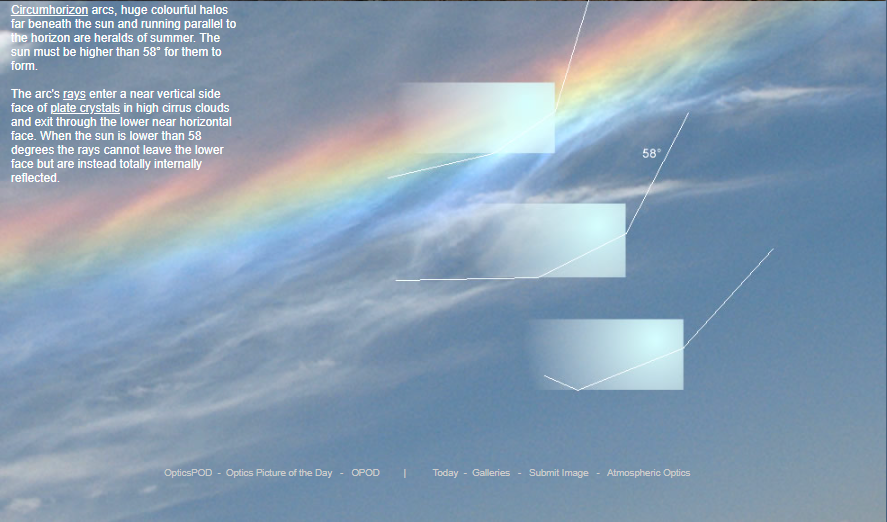Sign of Summer
Sign of Summer: Exploring the Spectacular Circumhorizon Arc
When the warm days of summer arrive, they bring with them a breathtaking atmospheric phenomenon known as the circumhorizon arc. These massive, colorful halos stretch far beneath the sun, running parallel to the horizon, and serve as heralds of the summer season. However, for this stunning optical display to occur, the sun must be positioned higher than 58° in the sky.
The formation of a circumhorizon arc involves a fascinating interplay of light and ice crystals in high cirrus clouds. As sunlight enters the near-vertical side face of plate-shaped ice crystals, it undergoes a series of intricate interactions before exiting through the lower near-horizontal face. When the sun is below 58 degrees, the rays of light are unable to escape through the lower face and are instead completely internally reflected.
This natural phenomenon captivates observers with its vibrant colors and expansive appearance. Here are some key details to deepen your understanding of the mesmerizing circumhorizon arc:
1. Optimal Conditions
To witness the spectacle of a circumhorizon arc, certain conditions must align:
- The sun must be positioned higher than 58° in the sky.
- High cirrus clouds containing plate-shaped ice crystals are necessary for light interaction.
- The observer should have an unobstructed view of the horizon to fully appreciate the arc's parallel alignment.
2. Rainbow of Colors
The circumhorizon arc showcases an array of brilliant colors, reminiscent of a rainbow. These colors result from the dispersion of sunlight as it passes through the ice crystals. Similar to how raindrops create a rainbow, the ice crystals act as prisms, separating sunlight into its constituent colors.
3. Optical Illusion
Despite its appearance, the circumhorizon arc is not a physical object suspended in the atmosphere. It is purely an optical illusion created by the interaction of sunlight with ice crystals. This illusion, however, is no less awe-inspiring and can span vast distances, enhancing the grandeur of the summer sky.
4. Geographic Considerations
The occurrence of circumhorizon arcs is dependent on geographic location. These arcs are more commonly observed in regions closer to the Earth's poles, where the sun reaches higher elevations in the sky during summer. Conversely, areas near the equator may rarely witness this phenomenon due to the sun's lower position in the sky throughout the year.
5. Seasonal Variations
While circumhorizon arcs are most often associated with summer, they can also appear during other seasons, provided the sun is positioned above 58°. In some higher latitude locations, these arcs may even be visible during spring or early autumn, adding an extra touch of enchantment to the transitioning seasons.
6. Similar Phenomena
The circumhorizon arc belongs to a family of atmospheric optical phenomena known as halos. These include other captivating displays like the circumzenithal arc and the sundog. Each phenomenon has its own unique characteristics and requires specific conditions to occur, making them equally intriguing subjects for observation and study.
In conclusion, the circumhorizon arc is a remarkable sign of summer that graces our skies with its vibrant colors and parallel alignment to the horizon. Understanding the science behind this phenomenon enhances our appreciation for the natural wonders that surround us. So, when summer arrives and the sun climbs higher in the sky, keep your eyes open for this captivating optical display that adds an extra touch of magic to the warmest season of the year.

Sign of Summer - Circumhorizon arc imaged by Dave Williams. McDowell Sonoran Preserve, Scottsdale, Arizona looking south from the Overlook Spur Trail above Windgate Pass on April 16, 2009 at approximately 1:00 pm. ©Dave Williams, shown with permission.

Circumhorizon arcs, huge colourful halos far beneath the sun and running parallel to the horizon are heralds of summer. The sun must be higher than 58° for them to form.
The arc's rays enter a near vertical side face of plate crystals in high cirrus clouds and exit through the lower near horizontal face. When the sun is lower than 58 degrees the rays cannot leave the lower face but are instead totally internally reflected.
Note: this article has been automatically converted from the old site and may not appear as intended. You can find the original article here.
Reference Atmospheric Optics
If you use any of the definitions, information, or data presented on Atmospheric Optics, please copy the link or reference below to properly credit us as the reference source. Thank you!
-
<a href="https://atoptics.co.uk/blog/sign-of-summer/">Sign of Summer</a>
-
"Sign of Summer". Atmospheric Optics. Accessed on November 26, 2024. https://atoptics.co.uk/blog/sign-of-summer/.
-
"Sign of Summer". Atmospheric Optics, https://atoptics.co.uk/blog/sign-of-summer/. Accessed 26 November, 2024
-
Sign of Summer. Atmospheric Optics. Retrieved from https://atoptics.co.uk/blog/sign-of-summer/.